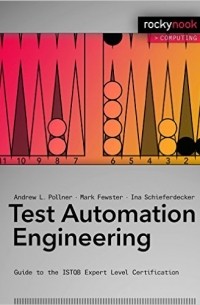
Автор
Mark Fewster
5.0
5.0
1оценка
Рейтинг автора складывается из оценок его книг. На графике показано соотношение положительных, нейтральных и негативных оценок.
| 5 | 1 | |
| 4 | 0 | |
| 3 | 0 | |
| 2 | 0 | |
| 1 | 0 | |
| без оценки |
0 |
1оценка
Mark Fewster — новинки
-
 Mark Fewster, Andrew Pollner, Ina Schieferdecker
Test Automation Engineering...
Mark Fewster, Andrew Pollner, Ina Schieferdecker
Test Automation Engineering...
ISBN: 9781937538088 Год издания: 2017 Издательство: Rocky Nook Язык: Английский Аннотация
Becoming an automated software testing expert first requires knowledge and understanding of an organizations development methodology, tools, schedules, and resources. Within this context, an overall strategy for implementing automated testing can unfold. Development of automated tests needs to be coordinated alongside other test activity and become part of the overall testing strategy. To successfully build and maintain a suite of automated tests requires the adoption of a process similar to application software development. In the world of automated tests, a framework describes those reusable components which form the basis of an automated testing program. An automated testing expert will assess the requirements of an organization, navigate the challenges posed by people and technology, and recommend, plan, implement, and maintain a process that maximizes the participation of all testers in creating automated scripts and analyzing run results. Expert automators should have broad knowledge of technical environments, hands-on experience with a variety of automated testing tools, and a technical background to ensure customization can be achieved. -
 Dorothy Graham, Mark Fewster
Experiences of Test Automation
Dorothy Graham, Mark Fewster
Experiences of Test Automation
ISBN: 978-0-321-75406-6 Год издания: 2012 Издательство: Addison-Wesley Язык: Английский Аннотация
Automated testing—it’s the Holy Grail, the Fountain of Youth, and the Philosopher’s
Stone all rolled into one. For decades, testers have looked to automated testing for
relief from the drudgery of manual testing—constructing test cases and test data, setting
system preconditions, executing tests, comparing actual with expected results,
and reporting possible defects. Automated testing promises to simplify all these
operations and more.
Unfortunately, successful, effective, and cost-effective automated testing is difficult
to achieve. Automated testing projects are often initiated only later to stumble,
lose their way, and be thrown onto the ever-growing pile of failed projects.
Automation fails for many reasons—unachievable expectations is perhaps the
most common, followed by inadequate allocation of resources (time, people, and
money). Other factors include tools that are poorly matched to needs, the sheer
impatience for success that hinders quality work, and a lack of understanding that
automated testing is a different kind of software development, one that requires the
same professional approach as all other development efforts.
Dorothy and Mark’s previous book, Software Test Automation: Effective Use of
Test Execution Tools, published in 1999, set the standard for books on this topic. The
first part detailed practices found in most successful automation efforts—scripting
techniques, automated comparison, testware architecture, and useful metrics. The
second part described the experiences of a number of organizations as they implemented
test automation efforts. Now, with an additional 10 years of industry knowledge
behind them, Dorothy and Mark provide another set of organizational and personal
experiences to guide our automation work. It brings us up to date, describing
both the classical and most modern approaches to test automation. Each chapter
tells a story of a unique automation effort—including both successes and failures—to
give us guidance.
Certain themes reoccur in Experiences in Test Automation: reasonable and
achievable objectives; management support; metrics, including return on investment;
required skills; planning; setting expectations; building relationships; tools; training;
and politics—all necessary to make test automation successful. However, these same
themes are equally applicable at both the project and personal levels. One great benefit
of this book comes from stepping outside the test automation realm and considering
these themes in the larger context.
I first met Dorothy and Mark at the 1998 EuroStar conference in Munich. I
was impressed with both their knowledge of and passion for helping others do great
automated testing. I congratulate them for their outstanding accomplishment and
commend this book to you.
--
Lee Copeland
December 2011